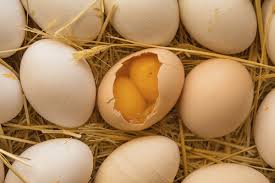

Once in a while, every poultry farmer finds her birds have laid abnormal eggs. Abnormal in the sense that the eggs have weak shells or internal defects. An occasional egg abnormality from the flock is no cause for panic, however, its persistency should be a matter of concern. Egg abnormalities in chicken can occur due to various factors.
In the absence of obvious disease symptoms such as sudden drop in production, respiratory problems and weight loss, potential environmental and dietary issues should be explored and once identified, remedied. While these abnormalities greatly affect the hatchability of the eggs, abnormal eggs can be consumed but those caused by infectious diseases are not safe for consumption and, thus, should be disposed.
Thin-shelled eggs or shell-less eggs are the most common defects in poultry farms. Young hens usually produce the first few eggs with shell defects since their reproductive tract is not fully matured. Upon maturity, the defect ceases and egg production peaks.
During this period, an occasional shell defect may occur and is nothing to worry about. It is mostly caused by temporary malfunctions in the shelling gland, the uterus or for some reason an egg is rushed through the uterus and laid prematurely.
Since the shell forms just before an egg is laid, stress induced by fright or excitement can cause a hen to expel an egg before the shelling process is finished. However, if these shell defects persist, they may be a sign of a serious disease, especially infectious bronchitis, which is accompanied by a drop in production and is highly-contagious with an infection rate of 100 per cent. However, if some hens are unaffected, this disease can be excluded.
Nutritional deficiencies, especially lack of Vitamin D or calcium impact the formation of the eggshell, resulting to abnormalities.
Calcium requirements in laying hens increase by age and warm weather. High temperatures reduce appetite, therefore, hens eat less and get less calcium from their rations. Nutritional deficiencies can be remedied by appropriate supplementation of the layers’ diet with crushed eggshells, limestone or limestone flour, and Vitamin A, D&E powder added to drinking water three times a week.
It should be noted that excessive consumption of calcium or phosphorus is likely to result in eggs with an abnormally thick or rough shells. Genetic defect could also be a cause for shell abnormalities.
Bloody shells sometimes appear when pullets start laying before their bodies are ready, causing tissue to tear.
In mature birds, this could be caused by excess protein in the layers’ ration or coccidiosis, a disease that causes intestinal bleeding, though not common in adult birds. Odd-shaped or wrinkled eggs may be laid if a hen has been handled roughly or if for some reason her ovary releases two yolks within a few hours of each other, causing them to move through the oviduct close together.
The second egg will have a thin, wrinkled shell that’s flat towards the pointed end. If it bumps against the first egg, the shell may crack and mend back together before the egg is laid, causing a wrinkle.
Small-sized eggs of less than 35grams usually don’t have yolks and such eggs can’t be used for hatching but may be consumed. This is common among young hens whose laying mechanisms have not fully matured. In matured hens, this could be indicative of pieces of reproductive tissues breaking away and stimulating the egg formation process in the reproductive tract.
Double yolk eggs occur when ovulation happens too rapidly or when one yolk becomes joined with another. This is mostly seen in young hens that have not reached reproductive maturity yet and have unsynchronized reproductive cycles (roughly, it takes 22 – 25 hours to form and lay an egg).
Blood spots inside the egg can be genetic, as well as sudden environmental temperature changes. The incidence of blood spots inside the egg also increases with age.
 Contact Jaguza Support
Contact Jaguza Support